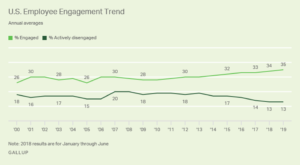Since Gallup began measuring employee engagement at the turn of the century, it hasn’t improved employee engagement much. It has helped companies realize the importance of empathetic and empowering leaders and collaborative team environments. But Gallup this month published a report that finally shows an increase in employee engagement scores. How it was achieved may surprise you.
Beginning with its first employee engagement survey in 2000, Gallup’s State of Global Workforce reports show that overall employee engagement, as measured by its survey, has not improved much. Between 2000 and 2018, actively engaged employee scores have ranged from 13% to 20%, and disengaged employee scores have ranged from 26% to 30%. Gallup almost always concludes that 70 percent of the workforce is disengaged. Pretty disappointing. Recently, Gallup has begun to tell organizations not to manage by an engagement score but by business metrics. Now, with their latest report, they are encouraging executives to develop their cultures. We agree.
With its latest report, Gallup found “that in 2019, the percentage of ‘engaged’ workers in the U.S. — those who are highly involved in, enthusiastic about and committed to their work and workplace — reached 35%.” This is a new high since Gallup began tracking the metric in 2000.
Gallup found that the percentage of workers who are “actively disengaged” — those who have miserable work experiences and spread their unhappiness to their colleagues — tied its lowest level (13%), consistent with the 2018 finding. Gallup reports this makes the ratio of engaged to actively disengaged workers 2.7-to-1, the highest ever in Gallup tracking. These findings are based on a random sample of 4,700 full- and part-time U.S. employees working for an employer from January to August 2019.
The remaining 52% of workers are in the Gallup “not engaged” category — those who are psychologically unattached to their work and company and who put time, but not energy or passion, into their work.
Traditional employee engagement doesn’t go far enough. Successful companies focus on building a better culture.
At InnovationOne®, our ground breaking independent research has found that companies that improve their business performance, do much more than the traditional definition of employee engagement to inspire, excite, and align employees to achieve company strategies and to innovate. These companies build transparent, collaborative, and developmental cultures.
Our InnovationOne Health Index© is empirically developed to assess and benchmark an organization’s capability and culture of innovation and entrepreneurialism. Besides, it generates practical actions to implement next quarter and over the next two years.
We have found that these highly innovative and financially successful companies have executives who treat innovation as a strategic imperative. They articulate not only a clear brand, but also strategies and goals that map out areas to improve the company’s innovation and business performance—and they cascade goals. They share competitive, customer and market information, and new trends. They invest in employee skills, organizational learning, the time and space to innovative, as well as labs, new product technology, and digital technology. They unleash employee creativity by inviting questioning and the sharing of ideas. Just as importantly, they have established clear processes for employees and external partners to move ideas forward and collaborate. They measure and track processes, results, and share the lessons of past and current teams, including what worked and didn’t work.
But that is not all. The executives of these innovation-leading companies empower their team leaders and teams to innovate, reallocate resources and to make decisions within the guideposts of their strategies, and business and financial milestones. Finally, they align their operations and sales and marketing teams to embrace change and commercialize their chosen innovations rapidly.
Gallup’s latest findings also point to the importance of developing culture. Gallup’s recent report has come to similar conclusions that go beyond the typical employee engagement handbook. What they have found is that to improve employee engagement, you really need to address culture and make it more collaborative, development based, and innovative.
Gallup has identified the following four themes that have led to the improvement in engagement. Note, their findings point to developing culture:
High-development cultures are CEO- and board-initiated. The CEOs of these companies do the following:
- They develop a well-defined purpose and brand — why the company exists and how it wants to be known. Everyone in the organization understands that employee engagement is a system for achieving unity of purpose and brand. Leaders explicitly connect engagement elements to their business issues.
- Top executives initiate the effort. They know that their attitudes, beliefs, and behaviors have a powerful cascading effect on their organization’s culture.
- Leaders of great workplaces don’t just talk about what they want to see in the management ranks — they live it.
- Leaders map out a course for improvement. They identify where the company is today and where they want it to be in the future.
- High-development cultures educate managers on new ways of managing — moving from a culture of “boss” to “coach.”
- The best organizations have leaders who encourage their teams to solve problems at the local level rather than using top-down commands.
- Engagement, performance and training are all aligned. Training is strengths-based and grounded in the 12 elements of engagement.
- Training is tailored to managers’ capacity. Managers with high performance and high team engagement receive more advanced curricula than those with lower performance and lower team engagement.
- High-development cultures practice companywide communication.
- The best organizations have exceptional CHROs who build systems that teach managers how to develop employees in line with their innate tendencies.
- These organizations have a designated “champions network” that communicates, collects best practices and answers questions.
- The ongoing collection of best-practice examples creates a vivid picture of what highly engaged teams look like.
- High-development cultures hold managers accountable.
- The companies in the Gallup study with the highest engagement levels see employee recognition as a means to develop and stretch employees to new levels of success.
- Tolerance of manager mediocrity does not exist in the best organizations. They define high-team performance based on a combination of metrics such as productivity, retention rates, customer service and employee engagement.
- The best organizations believe that not everyone should be a manager, and they create high-value career paths for individual contributor roles.
- The best organizations know there is no meaningful mission or purpose in the absence of clear expectations, ongoing conversations and accountability.
The evidence is very clear from multiple sources. For companies to excite their employees and external partners (suppliers, customers, and external collaborators) to join the company in innovating, embracing change, and improving business and financial success, they need to develop their cultures.
What is holding you back from developing your organization’s culture, unleashing the innovation of your employees and external partners, and improving the business and financial success of your company? For more powerful conclusions on the lessons from highly innovative companies, watch for the latest report on the 2019 Global State of Innovation from InnovationOne and The Conference Board, to be released soon.
Victor Assad is the CEO of Victor Assad Strategic Human Resources Consulting and managing partner of InnovationOne. He works with companies to improve their recruiting, HR operations, and develop extraordinary leaders, teams, and cultures of innovation. His new book is Hack Recruiting: the Best of Empirical Research, Method and Process, and Digitization. Subscribe to his weekly blogs at www.VictorHrConsultant.com.


